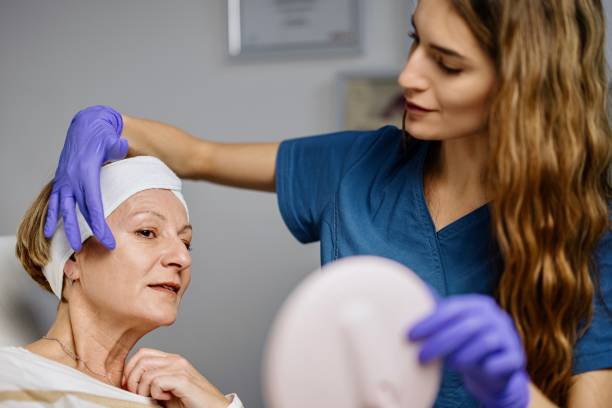Face and Neck Lift
Overview
 Many patients express concern that their faces will look too tight, or they have known someone who had a facelift that lasted no more than a few months. Unfortunately, some surgeons do not address the underlying cause of the signs of aging – sagging of the underlying structures of the face. Think of it this way: If you have a lumpy mattress, it won’t matter how tightly you pull the sheet over that mattress. It will still look lumpy. Similarly, if a surgeon makes the outer layer of skin tighter without tightening and shaping the under-structure of the face, the facelift results will be less than satisfactory.
Many patients express concern that their faces will look too tight, or they have known someone who had a facelift that lasted no more than a few months. Unfortunately, some surgeons do not address the underlying cause of the signs of aging – sagging of the underlying structures of the face. Think of it this way: If you have a lumpy mattress, it won’t matter how tightly you pull the sheet over that mattress. It will still look lumpy. Similarly, if a surgeon makes the outer layer of skin tighter without tightening and shaping the under-structure of the face, the facelift results will be less than satisfactory.
Our surgeons carefully evaluate the anatomy of your face to determine what exactly has caused the signs of aging. We then create a custom-tailored facelift surgical plan that is largely architectural in design. It is as much an art as it is a science. The muscles of the face are safely tightened so that the facelift and/or neck lift will not only look better in the short term but will also last for years.
“I was very nervous about my surgery, as it was my face. I had a lower face lift, nose job, and eye lift. I took the pre-surgical vitamins Dr. Hyans gave me, and they helped tremendously with the swelling and bruising. I went back to work in two weeks! Unheard of. The results have been amazing and day by day, I am really loving what I did. He and his staff are incredibly wonderful and knowledgeable. I would highly recommend him.”
Ready to get started?
The extent of the facelift procedure depends on your individual needs and desires. You are a good candidate for a facelift and neck lift if your skin has retained some elasticity and you have well-defined facial bone structure. Most people who get facelift and neck lift surgeries are between 40 and 70 years of age.
 Facelifts and neck lifts only affect the lower portion of the face. To create the most polished, balanced facelift results, you also might want to have eyelid surgery, a chin implant, a brow lift, Botox, dermal fillers, fat injections, or skin resurfacing. Some of our facelift patients decide to have a full facial rejuvenation so that both the upper and lower portions of the face can be improved at once. It is less costly to combine procedures, and they can usually be done concurrently so that you have only one episode of anesthesia and one recovery period.
Facelifts and neck lifts only affect the lower portion of the face. To create the most polished, balanced facelift results, you also might want to have eyelid surgery, a chin implant, a brow lift, Botox, dermal fillers, fat injections, or skin resurfacing. Some of our facelift patients decide to have a full facial rejuvenation so that both the upper and lower portions of the face can be improved at once. It is less costly to combine procedures, and they can usually be done concurrently so that you have only one episode of anesthesia and one recovery period.
Even for those patients who do not choose to have full facial rejuvenation, we often suggest the addition of dermal fillers, Botox, or skin resurfacing after a facelift in order to improve the results. Fine surface lines and wrinkles, for example, are not improved by a facelift but are improved with a skin resurfacing treatment like laser resurfacing, a chemical peel, or dermabrasion.
Types of Face and Neck Lifts
There is some confusion in the plastic surgery field as to what constitutes a facelift and neck lift. We use the terminology in a particular way in our practice, but bear in mind that other practices may use the same terms somewhat differently.
In our practice, there are four different types of facelifts and/or neck lifts:
- Facelift is used to treat aging of the cheeks and jowls.
- Neck lift treats bands and sagging in the neck. The facelift and neck lift are usually combined in one procedure.
- Mid-facelift only treats aging of the cheeks. This is for patients who do not have signs of aging in the jowls or neck.
- Mini-facelift (or “S lift”) only treats the jowls. It is for patients who do not have signs of aging in the cheeks or neck.
Face and Neck Lift Procedure
When you meet with us for your facial rejuvenation consultation, we will have an honest discussion about your desires, expectations, and concerns, as well as the limits and risks of the facelift and neck lift surgery. We will review your medical history and recommend options that can best help you achieve your goals. We will give you thorough written instructions to prepare for your facelift surgery and will answer any questions you have.
At Summit Health, the patient experience is of primary importance to us. We customize every single facelift and/or neck lift procedure we do so that it is tailored to what is best for you and you alone. We will recommend the facelift and/or neck lift technique that we believe will give you the results you want, whether you wish to treat the cheeks, the jowls, the neck, or a combination of those areas.
Our goal is to do safe and quality work – and to make you happy. Making you happy requires considerable discussion so that we thoroughly understand what you want to accomplish from your facelift surgery. Planning is very important. We spend a great deal of time working to understand exactly what parts of the anatomy between the upper hairline and the clavicle that you want to improve. Then, we can design your customized facelift surgery to provide you with the best results.
Your facelift and/or neck lift surgery will be performed under general anesthesia, but most patients do not have to stay overnight in the hospital.
Lower facelift and neck lift incisions are usually placed behind the ears, within the creases of the ears, within the hairline at the temples, underneath the chin, or behind the sideburns. We do everything we can to place incisions in discreet areas while also providing you with the outcome you want. If you wish to improve your neck, however, we cannot do so with an incision in the hairline at the temples. Similarly, we cannot lift the cheeks with an incision behind the ears. So, the areas you wish to be improved will have a lot to do with where the incisions are located.
During the facelift and/or neck lift surgery, excess skin and fatty tissue are removed, the muscles and under-structure of the face are tightened, reshaped, and the overlying skin is then gently tightened, redraped, and stitched into place.
You will be given thorough written instructions to prepare for and recover from your facelift procedure. The facelift and neck lift recovery time is largely the same for all of the different techniques. Expect some soreness, bruising, swelling, tightness, and numbness. Oral over-the-counter or prescription medications can be taken to manage any discomfort you experience.
Bruising and tenderness should subside within 7 to 10 days, and 90% of swelling usually goes away within 3 weeks after a facelift surgery. It may take a few months for all the tightness and numbness to resolve.
You will wear a gauze bandage around your neck and jaw line the first night after facelift surgery. In rare cases, tubes may be placed under the skin to drain any excess fluids during the first day or 2 of healing. We will see you in the office the next day to make sure that you are healing well.
Usually, all stitches are removed in 1 week. In most cases, you may shower within 2 days and dye your hair in 3 weeks. Most patients dye their hair a few days before their facelift surgery.
You will need to sleep sitting up for a few days to reduce swelling, but you should be able to return to work and normal, non-strenuous activities in about 2 weeks. We ask that for 3 weeks, you do not strain yourself with any exercise that could raise your blood pressure. High blood pressure is what causes bleeding under the skin. Light exercise can be resumed in 3 weeks, and strenuous exercise in 6 weeks.
You should be presentable 1 week after your facelift surgery, when it is safe to wear makeup to cover any residual bruising. Most patients are safe to drive after about a week. Most facelift and neck lift patients refrain from social activities for about 2 weeks. We do recommend that you wait 2 to 3 months before scheduling a big event after your facelift surgery, such as a wedding or presentation. Please be careful to wear sun block for 6 months after your facelift surgery.
You will need to follow up with your surgeon periodically for a year to check on your facelift recovery progress.
When the stitches have been removed, we will begin our scar regimen, which we continue for a few months to improve the incision areas as much as possible. We apply scar cream and perform massage. We also usually provide cortisone injections anywhere on the incisions where the skin might thicken. This prevents the scars from becoming raised and prominent.








